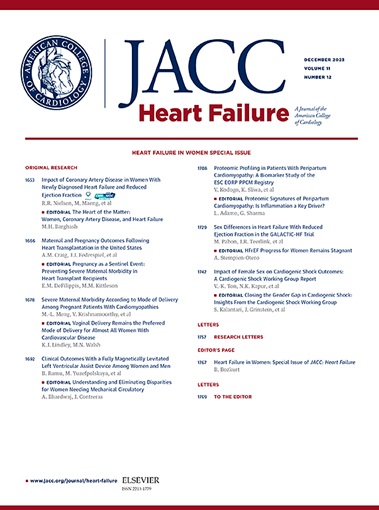Growth Hormone Replacement Therapy in Heart Failure With Reduced Ejection Fraction
IF 10.3
1区 医学
Q1 CARDIAC & CARDIOVASCULAR SYSTEMS
引用次数: 0
Abstract
Background
Growing evidence suggests that reduced activity of the growth hormone (GH)/insulin-like growth factor (IGF)-1 axis is common and associated with poor clinical status and outcome in heart failure (HF). In addition, preliminary results of growth hormone deficiency (GHD) correction in HF showed an improvement in quality of life, cardiac structure and function, and cardiovascular performance.
Objectives
The aim of the present double-blind, randomized, placebo-controlled trial was to evaluate the cardiovascular effects of 1 year of GH replacement therapy in a cohort of patients with heart failure and reduced ejection fraction (HFrEF).
Methods
Consecutive patients with HFrEF in NYHA functional class I/II/III and concomitant GHD were recruited. GHD patients were randomized to receive GH (0.012 mg/kg every second day ∼2.5 IU), or placebo, on top of background therapy. The primary endpoint was peak oxygen consumption (VO2). Secondary endpoints included hospitalizations, end-systolic left ventricular volumes, N-terminal pro–B-type natriuretic peptide (NT-proBNP) levels, health-related quality of life score, and muscle strength (handgrip).
Results
A total of 318 consecutive patients were screened, with 86 (27%) fulfilling the criteria for GHD. Of these, 22 subjects refused to participate in the study. The final study groups consisted of 64 patients, 30 randomized in the active treatment group and 34 in the control group. After 1 year, 45 patients completed the study (21 in the control group and 24 in the active group). A statistically significant improvement of peak VO2 was reached in the active group (from 12.8 ± 3.4 mL/kg/min to 15.5 ± 3.15 mL/kg/min; P < 0.01; delta peak VO2 between groups: +3.1 vs −1.8; P < 0.01). Other cardiopulmonary exercise test parameters (ie, peak workload, VO2 at the aerobic threshold, O2 pulse and VE/VCO2 slope; P < 0.05) also improved, paralleled by an increase in 6-minute walking test distance (P < 0.05) and handgrip strength (P < 0.01). GH improved right ventricular function (ie, TAPSE and TAPSE/pulmonary artery systolic pressure ratio; P < 0.01), leading to an amelioration of clinical status (NYHA functional class; P < 0.05) and health-related quality of life (Minnesota Living With Heart Failure Questionnaire; P < 0.05). A significant decrease of NT-proBNP was also found (P < 0.05).
Conclusions
This randomized, double-blind, placebo-controlled trial demonstrates that GH replacement therapy in HFrEF patients with GHD improves exercise performance, and left ventricular and right ventricular structure and function, leading to an amelioration of clinical status and health-related quality of life. (Treatment of GHD Associated With CHF; NCT03775993)
生长激素替代疗法治疗射血分数降低型心力衰竭:一项随机、双盲、安慰剂对照试验。
背景:越来越多的证据表明,生长激素(GH)/胰岛素样生长因子(IGF)-1轴活性降低是常见的,并与心衰(HF)的不良临床状态和结局相关。此外,生长激素缺乏症(GHD)纠正的初步结果显示,心衰患者的生活质量、心脏结构和功能以及心血管功能均有改善。目的:本双盲、随机、安慰剂对照试验的目的是评估心力衰竭和射血分数降低(HFrEF)患者1年生长激素替代治疗对心血管的影响。方法:连续招募NYHA功能分级为I/II/III级的HFrEF患者并合并GHD。GHD患者在背景治疗的基础上随机接受GH (0.012 mg/kg每2天~ 2.5 IU)或安慰剂。主要终点为峰值耗氧量(VO2)。次要终点包括住院、收缩末期左心室容积、n -末端前b型利钠肽(NT-proBNP)水平、健康相关生活质量评分和肌肉力量(握力)。结果:共筛查了318例连续患者,其中86例(27%)符合GHD标准。其中22名受试者拒绝参与研究。最终研究组由64名患者组成,其中30名随机分为积极治疗组,34名随机分为对照组。1年后,45例患者完成研究(对照组21例,治疗组24例)。活性组VO2峰值由12.8±3.4 mL/kg/min提高至15.5±3.15 mL/kg/min,差异有统计学意义;P < 0.01;组间峰值VO2: +3.1 vs -1.8;P < 0.01)。其他心肺运动试验参数(即峰值负荷、有氧阈值下的VO2、O2脉冲和VE/VCO2斜率;6分钟步行测试距离(P < 0.05)和握力(P < 0.01)均有改善。GH改善了右心室功能(即TAPSE和TAPSE/肺动脉收缩压比;P < 0.01),导致临床状况改善(NYHA功能分级;P < 0.05)和健康相关生活质量(明尼苏达心力衰竭患者问卷;P < 0.05)。NT-proBNP也显著降低(P < 0.05)。结论:这项随机、双盲、安慰剂对照试验表明,生长激素替代疗法可改善HFrEF合并GHD患者的运动表现,改善左室和右室结构和功能,从而改善临床状况和健康相关生活质量。GHD合并CHF的治疗;NCT03775993)。
本文章由计算机程序翻译,如有差异,请以英文原文为准。
求助全文
约1分钟内获得全文
求助全文
来源期刊

JACC. Heart failure
CARDIAC & CARDIOVASCULAR SYSTEMS-
CiteScore
21.20
自引率
2.30%
发文量
164
期刊介绍:
JACC: Heart Failure publishes crucial findings on the pathophysiology, diagnosis, treatment, and care of heart failure patients. The goal is to enhance understanding through timely scientific communication on disease, clinical trials, outcomes, and therapeutic advances. The Journal fosters interdisciplinary connections with neuroscience, pulmonary medicine, nephrology, electrophysiology, and surgery related to heart failure. It also covers articles on pharmacogenetics, biomarkers, and metabolomics.
 求助内容:
求助内容: 应助结果提醒方式:
应助结果提醒方式:


